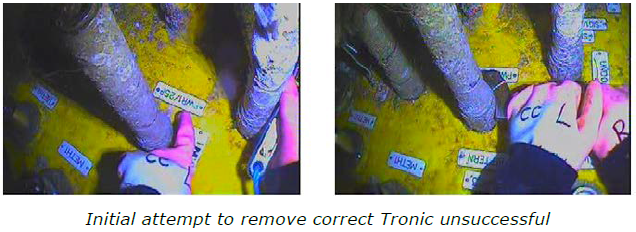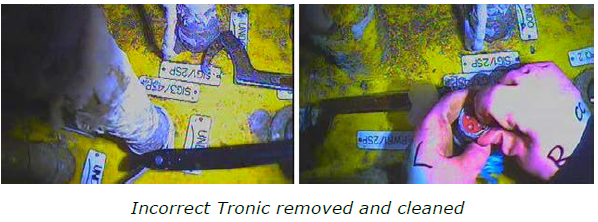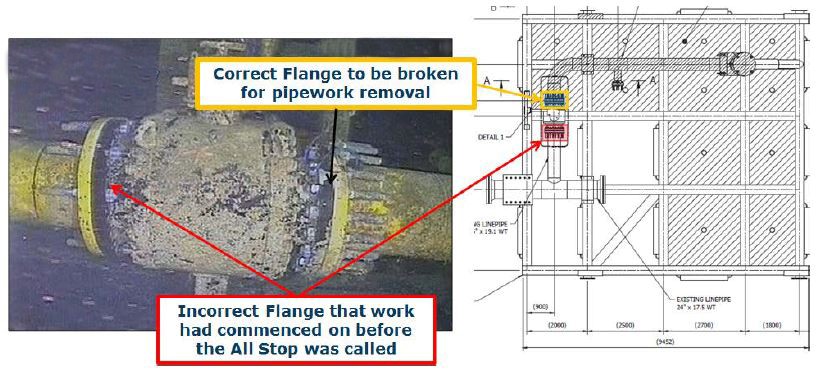Diver’s worksite identification errors
A member reports continued worksite identification errors by divers. This is in spite of a significant reduction in such errors following improved engineering procedures and the application of operational good practice. Mistakes are still being made, primarily when returning to the worksite after an initial correct identification.
Example 1:
During a recent dive, a Tronic connector was correctly identified by the diver on the panel with its corresponding jumper tail labelled back from the connector. Positive confirmation was provided by the team in Dive Control. There followed an unsuccessful attempt to loosen and remove this connector with a C-spanner.

In order to provide more leverage, it was decided to try a strap wrench so the diver moved away from the worksite to collect this tool. Crucially, the C-spanner was left on a different but adjacent connector and when the diver returned with the strap wrench he mistook this connector for the one previously identified. The error went un-noticed and the diver removed and cleaned the wrong connector.

The mistake was noticed while preparing to connect the jumper to the wrong port as the colours did not match. The job was immediately stopped and a “Time Out For Safety” held, before retracing the steps and continuing with the correct Tronic connector.
At no time was the diver or equipment at risk as the power was isolated.
Example 2:
Planned operations for removal of a section of pipework from a flange took two dives. The section to be removed was correctly identified during Dive number 1, but after bell turnaround and the meal break, during Dive 2, the incorrect flange was identified and the wrong bolts were removed.

After several bolts had been removed, the Dive Supervisor called an “All Stop”, as it was identified that work was being conducted on the wrong flange. A “Time Out for Safety” was called to discuss actions already taken and to agree the further actions needed. At no time were the divers or equipment at risk as the Pipeline End Manifold was shut down.
Our member notes that both of these recent incidents have their own set of contributory factors such as inadequate handover between Dive Supervisors in the second example, but both events featured identical failings which were consistent with previous incidents.
Actions:
- Increase focus/attention in setting up for worksite identification;
- Procedures and task plans should include steps to positively identify and mark the specific item to be worked on;
- Dive Supervisors should ensure the specific item to be worked on is positively identified and appropriately marked for intervention;
- Should the worksite be left, even momentarily, the item to be worked on should be reacquired and again positively identified before work resumes.
Members may wish to refer to the following incidents:
- Dropped object fell from crane – Poor communication/lack of awareness/control of work
- a job had to be left half-finished but this was not properly communicated or handed over – a causal factor was poor communication, particularly at shift handover.
- First aid injury: Electric shock
- the injured person mistakenly accessed the wrong transformer cabinet and got an electric shock. A lesson learnt identified was the importance of clear labelling and the ability of crew to differentiate between similar sets of co-located equipment.
Safety Event
Published: 3 May 2017
Download: IMCA SF 09/17
IMCA Safety Flashes
Submit a Report
IMCA Safety Flashes summarise key safety matters and incidents, allowing lessons to be more easily learnt for the benefit of all. The effectiveness of the IMCA Safety Flash system depends on Members sharing information and so avoiding repeat incidents. Please consider adding safetyreports@imca-int.com to your internal distribution list for safety alerts or manually submitting information on incidents you consider may be relevant. All information is anonymised or sanitised, as appropriate.
IMCA’s store terms and conditions (https://www.imca-int.com/legal-notices/terms/) apply to all downloads from IMCA’s website, including this document.
IMCA makes every effort to ensure the accuracy and reliability of the data contained in the documents it publishes, but IMCA shall not be liable for any guidance and/or recommendation and/or statement herein contained. The information contained in this document does not fulfil or replace any individual’s or Member's legal, regulatory or other duties or obligations in respect of their operations. Individuals and Members remain solely responsible for the safe, lawful and proper conduct of their operations.
